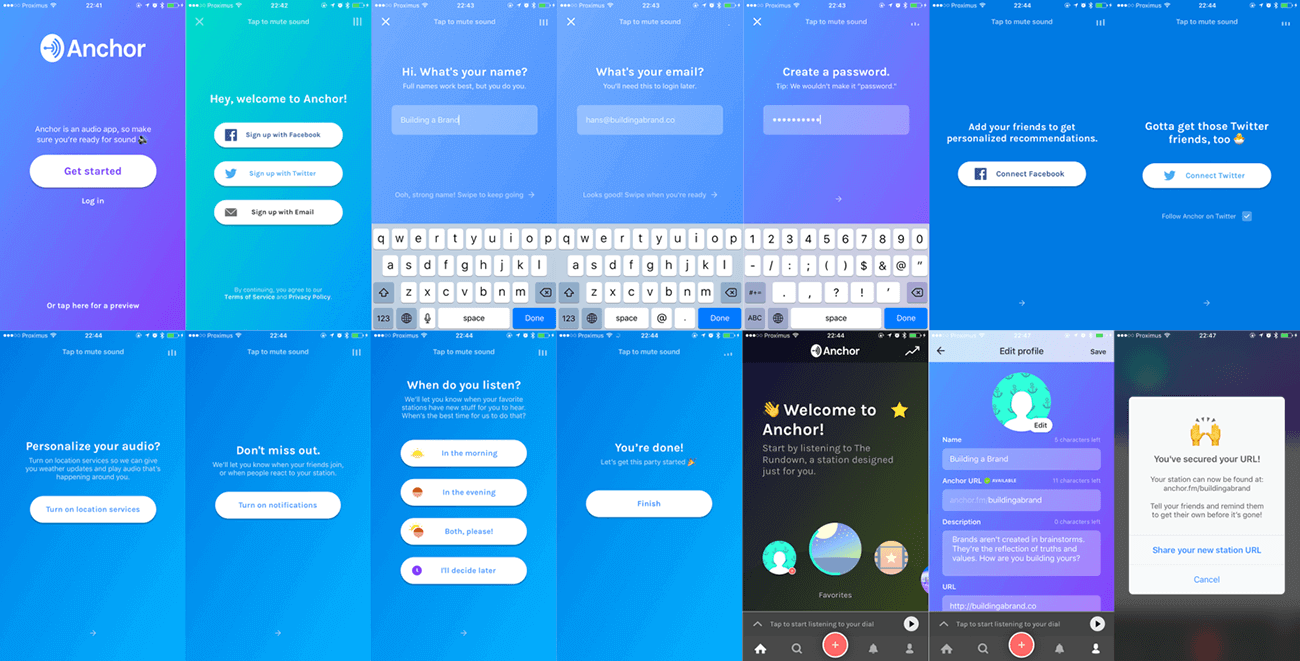
For consumers to get excited about something, for a potential customer to be compelled by something it comes down to attention. Attention, not impressions. So while some companies focus around getting as many impressions as possible on their banner ads, great marketers focus on attention.
Your leads, your customers they need to consume your content.
Over the last couple of years, there have only been two places that have gotten the attention of consumers. The first one is mobile, and all the social networks that are built on that mobile experience. The second one is content marketing.
After all, content marketing is just solving the same problems that your product solves through media you create and promote. You’re helping your customers making their life better by handing them solutions so they can empower themselves.
Within content marketing, you can see a trend moving towards more visual content. Businesses are moving towards Snapchat and building brands on Instagram. According to Cisco in 2019 video will even present 90% of all internet traffic.
The second big trend in content marketing is audio. Edison Research created a report with fascinating statistics about this trend. And while it is not only about podcasts, but also about online radio, streaming, social media and beyond, this post will focus mostly on the podcasting part.
Some number to give you an impression though:
- Podcast Listening Grew 23% Between 2015 and 2016
- 21% of Americans ages 12 and up have listened to a podcast in the past month (13% of the USA listens to Spotify monthly, and 21% of the country uses Twitter.)
- 64% of podcasts are being listened to on a smartphone or tablet.
- Weekly podcast listeners consume five shows per week on average
So how can you and your company take the most out of this growing trend? That’s where Anchor.FM comes into play.
For those who don’t know what Anchor yet is, it’s maybe best to let them describe themselves:
The new Anchor lets you broadcast your voice, clip external sound bites, mix in full-length tracks from Apple Music and Spotify, take call-ins from your listeners, and add interludes created by world class sound designers and musicians, all from your phone. Plus, everything on the new Anchor can be heard on iOS, Android, Amazon Echo, Google Home, web, and in your car via Bluetooth.
How to set up an Anchor account for your business

Creating an account on Anchor is a breeze
Creating an account on Anchor is a breeze, and their onboarding process is one of the easiest we’ve ever encountered. Every step is clearly laid out, and there is crystal sharp audio guiding you all the way.
Step 1: Install the application on your phone. (The Anchor app is available for iPhone and Android. After you installed it on your mobile phone, open it up and let’s guide you through the creation and setup of your account.
Step 2: Create an account using an email address. Some people like to create an account using their Facebook or Twitter handle, but in our opinion for corporate accounts, it is always best to create an account attached to an email address and connect social accounts at a later stage. (for easy recovery in case something goes wrong)
Step 3: On the next set of screens you can fill in some personal data, what is the name of your company, the email address you would like to register with and a password.
Step 4: After that most of the account creation has already been done. You can still add your Facebook friends (although as a business page that doesn’t add up that much), you can search for your friends on Twitter (does make sense), and of course, personalise the experience of Anchor from a listening perspective for yourself.
Step 5: Hit that finish button, and you’re almost ready to go.
Step 6: Go to your profile, claim your business name as a handle on Anchor, add a description, upload a profile picture and put in your company URL.
Step 7: Save your profile and share your new station URL with your followers to get your first sets of fans!
Setting up goals
Podcasting is still a bit of niche, trying to attract huge traffic numbers or generating tons of new clients is not automatically the first thing that seems realistic, especially since this is such a potential new space for your brand with zero followers to start with.
However, there are lots of people who don’t read blogs or watch YouTube videos, or merely don’t have the time, and audio content is the ideal content that can be consumed while your listeners are engaged in other activities.
According to Charlotte Crowley, former senior marketing assistant at Axonn Media, “The nature of podcasts is that they assume you’re multitasking, they can be consumed anytime, anywhere.”
Mark Burgess of Strategy explains: “Consumers – particularly millennial – are cramming their media consumption into all available moments, whether it’s at the gym, walking the dog, cooking or commuting, This is when you can reach them with a podcast.”
So how can you set S.M.A.R.T. goals for your audio content? Maybe you should think a bit beyond the numbers at first and use it mostly as an awareness tool.
By using podcasting as another offering for your content, you can give costumers who start following you access to information and resources that no one else has access to. You can give them behind the scenes look at your business, set up interviews with interesting guests who can tell a compelling story.
Podcasting is a unique method for attracting attention (with a potentially new and different audience) to your business. And on top of that Anchor gives the unique opportunity to build a deep relationship with your listeners by having them call into your podcast and making them part of the story. Helping turn the audience from a passive bystander to an active ambassador.
Potential goals you can look into for Anchor are:
- Reaching a global audience in ways, you could not reach before
- Building relationships with leads, customers and like minded people
- To be seen as an expert
- To educate, inspire, entertain
Creating an Anchor Content Strategy
IMAGE
Creating a podcast on Anchor is easy, you don’t need a super expensive microphone you just need your phone to start recording, you can add music tracks from Apple Music or Spotify in there, mix in soundbites from other or clips you created yourself and even include call-ins from your listeners.
And with the latest release of Anchor, you publish to major podcast outlets like Apple Podcasts and Google Play Music with a single tap of a button on your phone.
The danger of this though, is that it might become too easy and you forget about some basics content marketing strategies for you to make your business podcast a success.
How often and what is the ideal length?
The answer to this question is a bit different than you would expect for any “normal” social network. The only correct answer to these questions is; it depends. Let us clarify a bit by using a famous quote from Winston Churchill:
“A good speech should be like a woman’s skirt; long enough to cover the subject and short enough to create interest.”
And the same holds true for a good podcast or show on Anchor. It depends on the topics you’re creating a show about, talking for 2 hours doing a movie review doesn’t seem to make that much sense, but doing a great interview with a fascinating guest can take up longer like Jason Calacanis is doing with his This Week In STartups.
So as often as your audience wants it and as often as you can deliver value. There are a lot of people who can put out an (almost) daily show bringing lots of value like Medicine Remixed on Anchor in delightful short bites making it valuable to listen to. If you’re a small team and if this is one of the many channels you’re exploring you might want to do it a bit more relaxed.
The most important thing though is consistency, if you can bring value ones per week stick to that schedule and make it the best you can do. By being consistent, people start to know when to expect new content and can make it part of their routine.
Content topics
Depending on what your business does, or what products or services you’re creating coming up with content topics is almost the same as any piece of content marketing. You’re trying to solve the same problems that your product or services solve through audio. Because of the personal nature, it can also help bring a human side to your organisation.
Keeping this in mind, topics to include on your radio show could be:
- Questions and comments from your community.
- News feeds from your niche.
- What struggle are you currently facing? Ask your community for help.
- What obstacle have you recently overcome? Share how you did it.
- What are people talking about in social media?
- Be on the lookout for stories in your everyday life.
- Share the success of someone else.
- Invite a guest to come on your show for a “conversation” or interview.
- Re-using existing content from your blog
Building an audio (Anchor) brand for your business
Great brands aren’t created in brainstorms; great brands are created by doing, by not just talking the talk, but also walking the walk.
So how can you build a brand on Anchor? By not just sitting by and waiting till your competitors are taking over this space. Anchor is a social network that is just starting out, so there is a tremendous opportunity to start building your brand, by building an audience with a great podcast before they do.
But what to do after you created your account? What steps can you take to ensure getting a big following?
Be unique
Succesful brands speak with a unique voice. For a lot of companies, the foundation for this has already been made, when you thought of and created your brand’s voice. If not, think about what brands you admire? What podcast do you think are great to listen to? What makes them unique?
With the ability to broadcast your app straight to Apple Podcast and Google Play Music, people don’t need the Anchor app to start listening to you (although it is more fun).
This also means for the people not on Anchor your podcast becomes a part of the vast majority of podcasts already out there (and if Anchor becomes more popular this problem is coming to Anchor as well).
This means that there must be a reason for people to listen to your podcasts instead of listening to other content.
For people to give their attention to you, it comes down to personality, topics covered, etc. the more unique you are, the easier it will be to rise above your competitors. Don’t be scared to be yourself!
Consider your audience
What does your ideal audience look like? What type of content are they interested in? How often do they want to have a small break with some music? As with all content marketing, you’re creating your content for them.
The beautiful thing with Anchor is that it is more than just a simple podcasting app. It is a social network so that you can include your audience on your station. Answer questions they send to you by dialing-in live on your station. Engage with them, and the rest will come along naturally.
Be consistent
As we already mentioned earlier, it doesn’t matter which publishing schedule you come up with, as long as you stick to it.
Whether it is weekly, bi-weekly, or even monthly, your audience wants to know that Sunday evening is Game of Thrones night, and Wednesday morning they can expect a great new show from you.
Create a profile that is recognisable
Consistency doesn’t stop at your release schedule; consistency also involves being consistent in your branding across all social networks including Anchor. A professional looking logo is a core part of any visual branding and putting that logo to use on Anchor is no different than on your Facebook, Twitter, or Instagram. Use your profile as well for managing expectations about release schedules, the type of content, etc.
Use captions
After you finished creating a recording, Anchor gives you the option to “add a caption (optional)” to your audio to help identify your content better and help with discoverability to other people. Although this part is optional, it is highly recommended to do before hitting that “add to station” button.
Reach out to other Anchor users by dialling into their stations
This, may seem a bit counter productive, why would you want to potentially help out your ‘competitors’ right? But by being involved with them, getting featured on their shows, you will reach new sets of ears listening to you and have them turn to your profile to check out your content as well.
And since Anchor is only in its early days it is one big family ready to help out each other.
Reach out to other Anchor users by interacting using discussions
Last week Anchor introduced a cool new way for you to interact with the audio you love: discussions on Anchor. By tapping the new discussion button on a station you can start a text based discussion on the topics that you’re listening on.
If a host loves what you have to say, they can even add it to their segment as a pop-up comment so that all of their listeners will see it, even if they don’t choose to join the full discussion.
In other words, by delivering great value to other stations in the form of a discussion you can get easily featured on their station, giving a great opportunity to showcase your expertise and get new people to discover the value you can bring.
Don’t forget to add your station to your episodes
Recorded messages to your station will disappear after 24 hours. If you want to build a real podcast that will last the sands of time, you will need to go to your profile and select the option “+ Episode”. With this option, you can turn your current station into an episode to let others hear it forever and publish it to Apple Podcast and Google Play Music.
Use the web clipper
If you’re ready to take it up a notch, you can also make use of the Anchor Web Clipper, to import pre-existing audio from your desktop or the web. This way when using professional audio creation software to create your episodes you can still make use of all of the social features of Anchor.
Promote your station everywhere
Since Anchor takes out all the heavy work for you to create a podcast, it also means they have an RSS feed ready for you available to submit to different podcast directories next to Apple Podcast and Google Play Music, places like Stitcher, Breaker, Overcast, Pocket Casts.
Include the URL to your station in the bios on your other social networks, share it via a post on your Facebook, Twitter, etc.
At first, podcasting seemed like a lot of work, but with the arrival of Anchor, it doesn’t have to be. You don’t need a super expensive microphone or a fancy sound mixing board or application anymore to start tapping into the vast audiences that enjoy consuming content by listening to podcasts.
Using audio for your content marketing allows your target audience to feel your personality, your passion and hear your enthusiasm when you speak about your topic and business.
Podcasting is here to stay and creates a valuable new channel to help build your online brand. So get out there and start your first audio episode, if you haven’t done so already. And if you did, leave a comment below so our readers can check out the vast set of knowledge that you’re sharing with the world.

